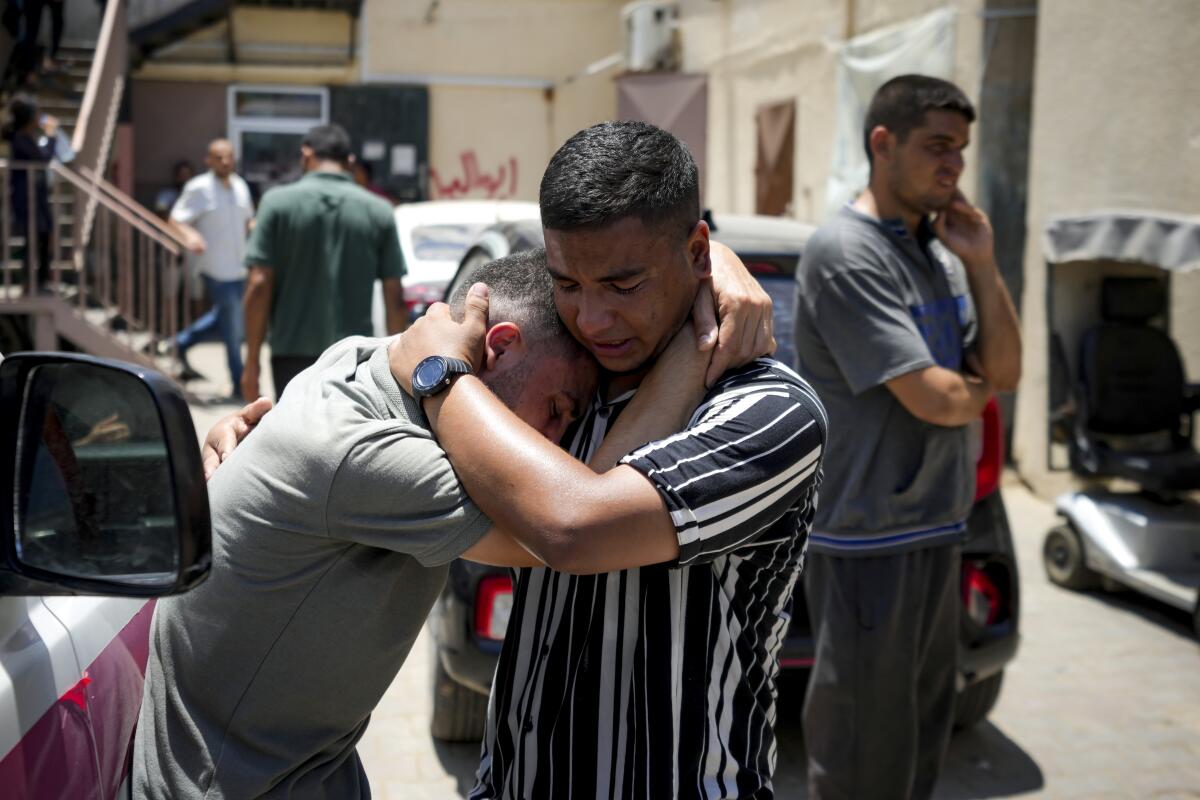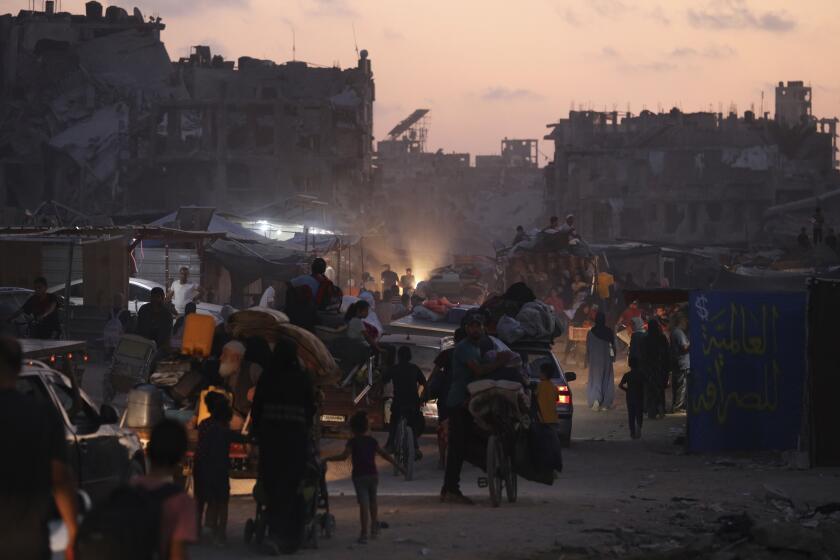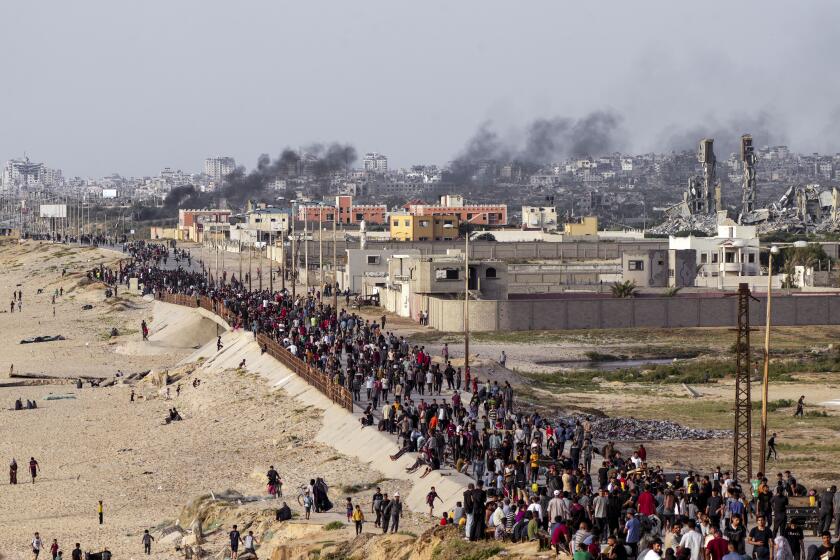Heavy Israeli bombardment in Gaza City forces medical facilities to close as thousands flee

- Share via
DEIR AL BALAH, Gaza Strip — Heavy Israeli bombardment shook Gaza City on Tuesday as thousands of fleeing Palestinians searched for shelter and medical facilities were forced to shut down in the latest offensive in the territory’s north.
Separately in southern Gaza, an apparent Israeli airstrike on a school where displaced people were sheltering killed at least 19 and wounded dozens more, according to Palestinian health officials, who said the toll was likely to climb. There was no immediate comment from the Israeli military.
Israel’s new ground assault in Gaza’s largest city is its latest effort to battle Hamas militants regrouping in areas the army previously said had been largely cleared.
Large parts of Gaza City and urban areas around it have been flattened or left a shattered landscape after nine months of fighting. Much of the population fled earlier in the war, but several hundred thousand Palestinians remain in the north.
“The fighting has been intense,” said Hakeem Abdel-Bar, who fled Gaza City’s Tuffah district to the home of relatives in another part of the city. He said Israeli warplanes and drones were “striking anything moving” and that tanks had moved into central districts.
There was no immediate word on casualties. Families whose relatives were wounded or trapped were calling for ambulances, but first responders could not reach most of the affected districts because of the Israeli operations, said Nebal Farsakh, a spokesperson for the Palestinian Red Crescent Society.
Israeli forces are advancing deeper into the Gaza Strip’s largest city in pursuit of militants who have regrouped there.
“It’s a dangerous zone,” she said.
After Israel on Monday called for an evacuation from eastern and central parts of Gaza City, staff at two hospitals — Ahli Arab and the Patient’s Friends Benevolent Society — rushed to move patients and shut down, the United Nations said. Farsakh said all three medical facilities run by the Red Crescent in Gaza City had closed.
Scores of patients were transferred to the Indonesian Hospital in northern Gaza, which itself was the scene of heavy fighting earlier in the war. “We do not know where to go. There is no treatment and no necessities for life,” said Mohammad abu Naser, who was being treated there. “We are dying slowly.”
The Israeli military on Tuesday said it had told hospitals and other medical facilities in Gaza City that they did not need to evacuate. But hospitals in Gaza have often shut down and moved patients at any sign of possible Israeli military action, fearing raids.
In the past nine months, Israeli troops have occupied at least eight hospitals, causing the deaths of patients and medical workers along with massive destruction to facilities and equipment. Israel has claimed Hamas uses hospitals for military purposes, though it has provided only limited evidence.
An Israeli airstrike killed a prominent Palestinian doctor and eight members of his extended family after they complied with orders to evacuate.
Only 13 of Gaza’s 36 hospitals are functioning, and even those only partially, according to the U.N.’s humanitarian office.
Israel’s campaign in Gaza, triggered by Hamas’ Oct 7 attack, has killed or wounded more than 5% of Gaza’s 2.3 million Palestinians, according to the territory’s Health Ministry. Nearly all Gazans have been driven from their homes. Many have been displaced multiple times. Hundreds of thousands are packed into sweltering tent camps.
The U.N. humanitarian office said the exodus in Gaza City was “dangerously chaotic,” with people instructed to flee through neighborhoods where fighting was underway.
“People have been observed fleeing in multiple directions, not knowing which way may be safest,” the agency said in a statement. It said the largest U.N. bakery in the city was forced to close, and that the fighting had blocked aid groups from accessing warehouses.
Maha Mahfouz, a mother of two, said she fled twice in the last 24 hours. She first rushed from her home in Gaza City to a relative’s house in another neighborhood. When that became dangerous, she fled Monday night to Shati, a decades-old refugee camp that has grown into an urban district, where Israel has carried out repeated raids.
She described vast destruction in the city’s eastern and central parts. “The buildings were destroyed. The roads were destroyed. All has become rubble,” she said.
The strike in southern Gaza hit the entrance of a school-turned-shelter in a village near Khan Yunis, wounding at least 53 in addition to the dead, the Health Ministry said. Weam Fares, the spokesman for Nasser Hospital in Khan Yunis, where the casualties were taken, said the dead included at least seven women and children and that ambulances were en route with more casualties.
Earlier airstrikes in central Gaza killed at least 14 people, including a woman and four children, according to two hospitals that received the bodies.
Disagreements over the endgame could doom the Israel-Hamas cease-fire deal if the warring sides aren’t willing to negotiate.
The Israeli military has said it had intelligence showing that militants from Hamas and the smaller Islamic Jihad were regrouping in central Gaza City. Israel accuses Hamas and other militants of hiding among civilians. In Shijaiyah, a Gaza City neighborhood that has seen weeks of fighting, the military said it had destroyed three miles of Hamas tunnels.
Hamas has warned that the latest raids in Gaza City could lead to the collapse of negotiations for a cease-fire and hostage-release deal.
Israel and Hamas had appeared to narrow the gaps in recent days, with the U.S., Egypt and Qatar mediating.
CIA Director William Burns met with Egyptian President Abdel Fattah Sisi on Tuesday in Cairo to discuss the negotiations, Sisi’s office said. More talks were to be held Wednesday in Qatar, where Hamas maintains a political office.
Most postwar plans floated by diplomats and world leaders seem doomed to fail. Here’s a look at the leading ideas for what to do with the Gaza Strip.
But obstacles remain, even after Hamas agreed to relent on its key demand that Israel commit to ending the war as part of any agreement. Hamas still wants mediators to guarantee that negotiations conclude with a permanent cease-fire, according to two officials with knowledge of the talks.
The current draft says mediators “will do their best” to ensure that negotiations lead to an agreement to wind down the war. Israel has rejected any deal that would force it to end the war with Hamas intact. Hamas on Monday accused Israeli Prime Minister Benjamin Netanyahu of “putting more obstacles in the way of negotiations.”
Hamas’ cross-border raid on Oct. 7 killed 1,200 people in southern Israel, most of them civilians, according to Israeli authorities. The militants took roughly 250 people hostage. About 120 are still in captivity, with about a third said to be dead.
Israel’s bombardment and offensives in Gaza have killed more than 38,200 people and wounded more than 88,000, according to the territory’s Health Ministry, which does not distinguish between combatants and civilians in its count.
Shurafa and Magdy write for the Associated Press. Magdy reported from Cairo.
More to Read
Sign up for Essential California
The most important California stories and recommendations in your inbox every morning.
You may occasionally receive promotional content from the Los Angeles Times.














